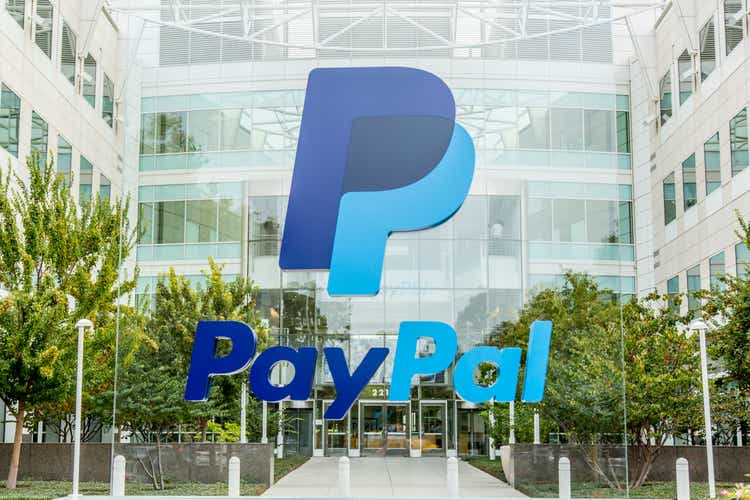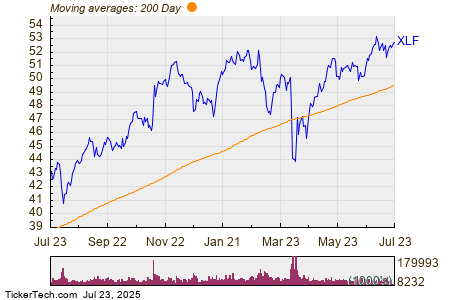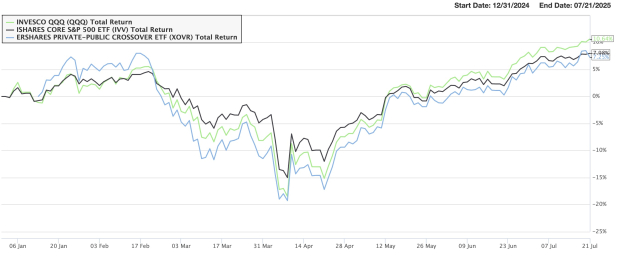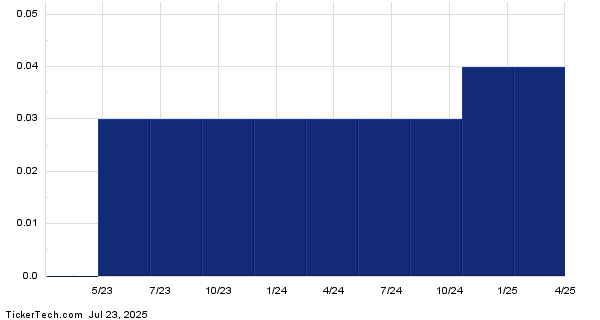
Remember how Meta Platforms, Inc. (META) performed from 2021 to 2023?
The company went through a rollercoaster ride, dropping from its peak of about $380 to a low of $88 amid a slowing economy, higher rates, and a decline in overall ad spending.
External factors such as an economic slowdown and ad spending slowdown played a role, but Meta’s own choices, like diving into the metaverse and burning through cash quickly, added to the negative sentiment toward the company’s management.
But then, after hitting rock bottom in late 2022, the stock bounced back big time. In 2023, it shot up by over 194%, becoming the second-best performing stock right after NVIDIA Corporation (NVDA), which returned 239%.
It’s a clear example of how emotions drive the market. Even when a company’s fundamentals stay the same, stocks can swing wildly from being overvalued to undervalued in no time.
Similarly, PayPal Holdings, Inc. (NASDAQ:PYPL) has experienced a bumpy ride, despite being a fundamentally robust company with a healthy business model and a history of continuous growth without focusing on cost-cutting initiatives.
Although it had an impressive performance from 2020 to 2021, things took a turn from 2022 to 2023, and the company has been struggling lately.
I believe the negativity surrounding the company isn’t justified. They’re growing reasonably fast, and the favorable industry tailwinds coupled with cost-cutting initiatives should catapult them forward, just as we witnessed with Meta.
PayPal’s Business Update
During the pandemic, digital payment companies like PayPal thrived as people relied more on online transactions. PayPal’s revenue soared from $17.8 billion in 2019 to over $25 billion in 2021, and its stock reached unprecedented heights of $289.
However, as pandemic restrictions eased, PayPal’s stock growth took a nosedive. In just a year, it lost all the gains it had made during the pandemic, due to disappointing earnings reports, and today is trading at $58.
When the pandemic was at its peak, online sales made up 16.4% of total retail sales in the U.S. But since then, the growth has slowed down, hovering below 15% for the past two years.
Although PayPal’s overall payment volume has been increasing steadily, its stock growth has slowed. The rise in competition within the digital payment sphere has played a significant role in this slowdown.
In my opinion, investor worries which have pushed PayPal’s stock down 80% are way overdone and this presents a good investment opportunity with a significant margin of safety.
Currently, PayPal manages a worldwide network with around 430 million active accounts, facilitating $1.5 trillion in payment volume through 24 billion transactions. Their operations span across 200+ global markets.
In my opinion, Q3 2023 signaled a turning point for the slower growth, with a 9% revenue increase, reaching $7.8 billion. This surpassed management’s original guidance of 6% to 7% growth for the quarter.
Though sales growth hasn’t been as robust as many hoped, several other key indicators are looking quite robust. Despite a decrease in active accounts, transactions per account have surged by 13% to 56.6, with total transaction growth rising by 11% to 6.3 billion.
Operating income has seen an 8% uptick to $1.06, while Non-GAAP EPS hit $1.30, marking a substantial 20% year-on-year increase and surpassing the original guidance midpoint by $0.07. This EPS growth was significantly fueled by share buybacks, as PayPal repurchased close to 5% of outstanding shares in the last 12 months.
The robust lineup of products within PayPal’s portfolio, including Venmo, Xoom, and Braintree, has propelled total payment volume or “TPV” to $388 billion, marking a 15% increase from the previous year and the swiftest growth in the past six quarters.
Given the substantial recovery in TPV, which I consider the most important metric of PayPal, from the 5% to 9% growth lows experienced by PayPal between Q2 2022 and Q4 2022, I anticipated the stock to have already rebounded. This growth recovery hasn’t been a one-time event but has persisted over the past three quarters. Surprisingly, investors seem to underappreciate this growth recovery, despite the new CEO, Alex Chriss, making what appears to be the right decisions in terms of innovation.
Investors are primarily concerned about rising competition and shrinking margins at PayPal, which holds true as its operating margin declined from approximately 23% in Q2 2019 to 22.2% in Q3 2023. At the peak of the pandemic, the company’s operating margin hit 28%.
In a statement on November 1, PayPal’s CEO highlighted, “Our cost base remains too high, it is actually slowing us down.” The CEO outlined plans to significantly reduce costs, aiming for $900 million in cuts, mainly through layoffs, consolidating real estate, and cutting back on projects. This was evident in the 7% reduction in headcount announced in January 2023, involving the elimination
PayPal Positioned for a Profitable Comeback
PayPal, the digital payment giant, has announced a reduction in its workforce by 2,000 positions. This strategic cost-cutting move is intended to streamline operations and boost efficiency. Similar to Meta’s successful turnaround, the initiative is likely to result in improved margins, which may attract a more bullish stance from investors toward PayPal stock.
The upcoming release of PayPal’s Q4 2023 earnings on January 30 is eagerly anticipated. The projected EPS stands at $1.36, indicating an estimated growth of approximately 10%. Furthermore, the net revenue is expected to show a healthy increase within the 7-8% range.
Given the recent surge in holiday e-commerce, as evidenced by the record-breaking $9.8 billion in US online sales during Black Friday, signaling a 7.5% YoY increase, PayPal is set to capitalize on this trend, potentially translating to a positive impact on its financial performance.
Financial Valuation
PayPal’s stock is currently trading at a Blended P/E of 11.72x. In previous years, the company’s typical P/E Ratio was 33.96x. Although this figure might seem inflated due to the trading frenzy of 2020 and 2021, PayPal managed to maintain an impressive 15.9% growth rate in its EPS during that period.
Despite a decline in EPS by -10% in 2022, the cost-cutting measures and robust share buybacks in 2023 facilitated a recovery year for PayPal. Projections indicate that PayPal is on track to sustain an annual EPS growth of around 10% in the coming years:
- 2023: EPS of $4.98, 21% growth.
- 2024: EPS of $5.53, 11% growth.
- 2025: EPS of $6.25, 13% growth.
- 2026: EPS of $6.54, 5% growth.
The current PEG ratio of 1.07 indicates that with an anticipated 11% growth for the upcoming year and a Blended P/E of 11.72x, PayPal’s stock is presently trading at a relatively undervalued level compared to its peers and within other growth sectors.
Comparing PayPal to other companies in the payment industry and other growth sectors, it’s evident that PayPal is trading at a surprisingly low valuation, with considerable potential for upside based on its growth prospects.
Potential Return on Investment
If PayPal were to trade more in line with a reasonable valuation – say a Blended P/E of 29x for a company with around 10% EPS growth, the potential annual return could soar to 48.4% by 2026, reaching a stock price of $190.40. In a shorter term scenario, a price target of $161 by the end of 2024, assuming PayPal earns $5.53 per share, suggests a one-year return of 178% from its current price.
In essence, PayPal’s recent undervaluation paints a picture of limited market expectations for future growth, despite analysts foreseeing an average EPS growth of 10% over the next three years. Therefore, with a blended P/E of 11.72x and a PEG ratio of 1.07, it’s plausible that PayPal is on the cusp of a renaissance akin to what transpired with Meta, potentially leading to renewed interest and a return to a more fitting valuation.
Conclusion
While PayPal has faced several quarters of underwhelming results, it remains a highly profitable business. The company is well-positioned to benefit from the buoyant e-commerce landscape, with its new CEO’s focus on innovation and cost-cutting measures anticipated to yield positive results in the near future.
Considering PayPal’s current valuation and its potential for strong EPS growth, the stage seems set for a turnaround. If the company manages to deliver on its anticipated growth trajectory, investors could be in for a substantial upward ride, much like what was witnessed with Meta’s resurgence.
With the prospect of achieving a 48% return by 2026, PayPal’s current undervaluation presents a compelling opportunity for investors. Whether the turnaround materializes within the next year or takes a bit longer, PayPal seems poised to reward investors handsomely in the coming years.
Its also worth noting tech stocks like NVIDA are exploding upwards. While PYPL is not a semi-conductor stock, money if flowing into the tech sector like never before!








